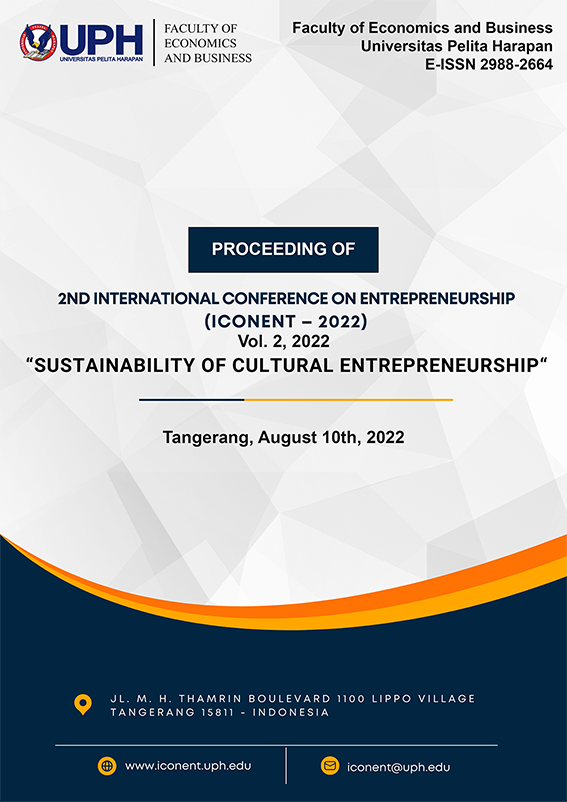THE INFLUENCE OF GENDER DIFFERENCES OF COMPANY EXECUTIVES IN INDONESIA AGAINST THE RISK OF FALLING STOCK PRICES
Keywords:
CEO, gender executive, stock priceAbstract
The purpose of this study is to determine the influence of gender differences between men and women on the risk of falling company stock prices in Indonesia. The study also wants to see if female executives have a positive or negative influence on the risk of falling stock prices. This study has an observation in which there are 433 companies listed on the Indonesia Stock Exchange from 2010 to 2019 with certain criteria. There are 2 models used in this study, namely the Logit Model, and the Generalized Method of Moments (GMM). The results showed that female executives did not have a significant influence on the risk of falling company stock prices. In addition, the position of the CFO compared to the CEO also does not have a significant positive influence in influencing the risk of falling stock prices.
References
Safe, H. (2013). An analysis of the impact of media coverage on stock price crashes and jumps: Evidence from Japan. Pacific Basin Finance Journal. https://doi.org/10.1016/j.pacfin.2013.02.003
Arellano, M., & Bover, O. (1995). Another look at the instrumental variable estimation of error-components models. Journal of Econometrics. https://doi.org/10.1016/0304-4076(94)01642-D
Ball, R. (2009). The Global Financial Crisis and the Efficient Market Hypothesis: What Have We Learned? Journal of Applied Corporate Finance. https://doi.org/10.1111/j.1745-6622.2009.00246.x
Bertrand, M., & Schoar, A. (2003). Managing with style: The effect of managers on firm policies. Quarterly Journal of Economics. https://doi.org/10.1162/003355303322552775
Chen, J., Hong, H., & Stein, J. C. (2001). Forecasting crashes: Trading volume, past returns, and conditional skewness in stock prices. Journal of Financial Economics. https://doi.org/10.1016/S0304-405X(01)00066-6
Dimson, E. (1979). Risk measurement when shares are subject to infrequent trading. Journal of Financial Economics. https://doi.org/10.1016/0304-405X(79)90013-8
Frank, M. Z., & Goyal, V. K. (2011). Corporate Leverage: How Much Do Managers Really Matter? SSRN Electronic Journal. https://doi.org/10.2139/ssrn.971082 Graham, J. R., Harvey, C. R., & Puri, M. (2013). Managerial attitudes and corporate actions. Journal of Financial Economics. https://doi.org/10.1016/j.jfineco.2013.01.010
Huang, J., & Kisgen, D. J. (2013). Gender and corporate finance: Are male executives overconfident relative to female executives? Journal of Financial Economics. https://doi.org/10.1016/j.jfineco.2012.12.005
Hudgens, G. A., & Fatkin, L. T. (1985). Sex differences in risk taking: Repeated sessions on a computer-simulated task. Journal of Psychology: Interdisciplinary and Applied. https://doi.org/10.1080/00223980.1985.10542887
Hutton, A. P., Marcus, A. J., & Tehranian, H. (2009). Opaque financial reports, R2, and crash risk. Journal of Financial Economics. https://doi.org/10.1016/j.jfineco.2008.10.003
Jin, L., & Myers, S. C. (2006). R2 around the world: New theory and new tests. Journal of Financial Economics, 79(2), 257-292. https://doi.org/10.1016/j.jfineco.2004.11.003
Kim, J. B., Li, Y., & Zhang, L. (2011a). CFOs versus CEOs: Equity incentives and crashes. Journal of Financial Economics. https://doi.org/10.1016/j.jfineco.2011.03.013
Kim, J. B., Li, Y., & Zhang, L. (2011b). Corporate tax avoidance and stock price crash risk: Firm-level analysis. Journal of Financial Economics. https://doi.org/10.1016/j.jfineco.2010.07.007
Kim, J. B., Wang, Z., & Zhang, L. (2016). CEO Overconfidence and Stock Price Crash Risk. Contemporary Accounting Research. https://doi.org/10.1111/1911-3846.12217
Larwood, L., & Whittaker, W. (1977). Managerial myopia: Self-serving biases in organizational planning. Journal of Applied Psychology. https://doi.org/10.1037/0021-9010.62.2.194
Levin, I. P., Snyder, M. A., & Chapman, D. P. (1988). The interaction of experiential and situational factors and gender in a simulated risky decision-making task. Journal of Psychology: Interdisciplinary and Applied. https://doi.org/10.1080/00223980.1988.9712703
Li, Y., & Zeng, Y. (2019). The impact of top executive gender on asset prices: Evidence from stock price crash risk. Journal of Corporate Finance. https://doi.org/10.1016/j.jcorpfin.2019.07.005
Lundeberg, M. A., Fox, P. W., & Punćochaŕ, J. (1994). Highly Confident but Wrong: Gender Differences and Similarities in Confidence Judgments. Journal of Educational Psychology. https://doi.org/10.1037/0022-0663.86.1.114
Malmendier, U., & Tate, G. (2005). CEO overconfidence and corporate investment. Journal of Finance. https://doi.org/10.1111/j.1540-6261.2005.00813.x
Manuel Arellano and Stephen Bond. (1991). Some Tests of Specification for Panel Data: Monte Carlo Evidence and an Application to Employment Equations. Review of Economic Studies.
Petersen, M. A. (2009). Estimating standard errors in finance panel data sets: Comparing approaches. In Review of Financial Studies. https://doi.org/10.1093/rfs/hhn053
Roodman, D. (2009). How to do xtabond2: An introduction to difference and system GMM in Stata. Stata Journal. https://doi.org/10.1177/1536867x0900900106
Svenson, O. (1981). Are we all less risky and more skillful than our fellow drivers? Acta Psychologica. https://doi.org/10.1016/0001-6918(81)90005-6 Wooldrige, J. M. (2016). Introductory Econometric 6 th. Cencage Learning.

 Fakultas Ekonomi dan Bisnis | Universitas Pelita Harapan | Kampus Universitas Pelita Harapan | Gedung F Lt. 12 | Lippo Karawaci, Tangerang - 15811 | Telp 021-5460901 | Fax 54210992
Fakultas Ekonomi dan Bisnis | Universitas Pelita Harapan | Kampus Universitas Pelita Harapan | Gedung F Lt. 12 | Lippo Karawaci, Tangerang - 15811 | Telp 021-5460901 | Fax 54210992